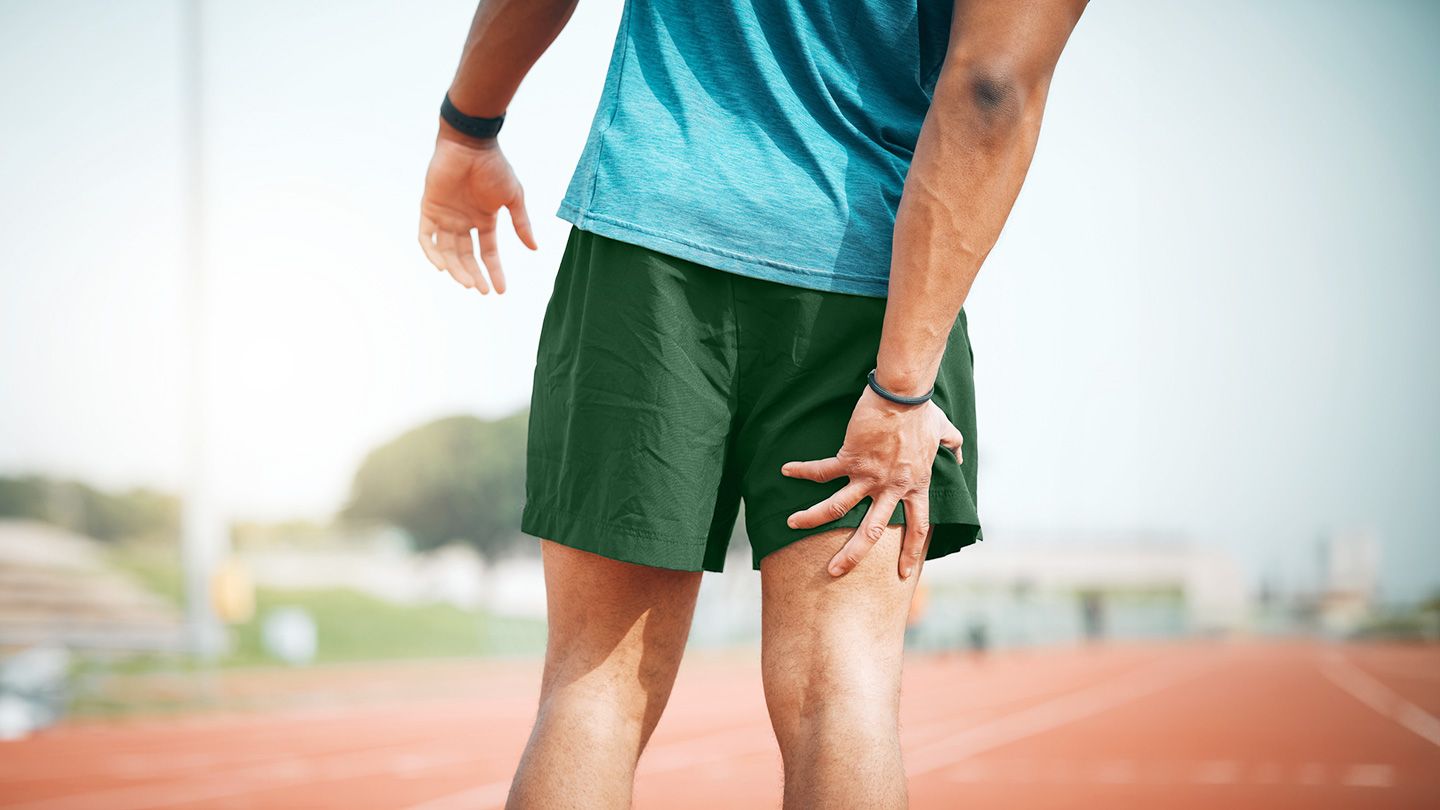Running has a lot of benefits, like improved fitness and heart health, weight maintenance, strengthened bones, and boosted mood, according to Mayo Clinic. But for all its positive aspects, it can be hard on the body.
If your thighs hurt after running, you’re not alone. Thigh pain is a common complaint among runners, and it can be a stubborn problem to solve. Pinpointing the issue and the best treatment protocol will have you pounding the pavement again in no time.
Causes of Upper Leg Pain After Running
A brief anatomy lesson will help you more accurately identify the cause of your upper thigh pain from running. The major muscles in your thighs are the quadriceps and the hamstrings. Both muscle groups originate at the pelvis.
According to Cleveland Clinic, the quadriceps on the front of the thighs are a group of four muscles: the rectus femoris, vastus lateralis, vastus medialis, and vastus intermedius. This group is responsible for extending your legs at the knees.
The hamstring muscle group along the backs of the thighs consists of three muscles: the semitendinosus, semimembranosus, and biceps femoris, per the American Council on Exercise. These three muscles are involved in flexing the knees.
Another group of concern is the hip flexors; these smaller muscles are located at the top of the thighs and across the front of the hips. There are several hip flexor muscles, but the main four are the sartorius, rectus femoris, iliacus, and psoas. The last two together are often referred to as the iliopsoas.
There are many causes for leg pain, from simple overuse to underlying conditions that require medical treatment. If pain from running is chronic or gets worse with time, a visit with your doctor can help you get to the bottom of your upper thigh pain.
In the meantime, here are a few of the most common causes of upper thigh pain in runners.
Hip Flexor Strain
A hip flexor strain is an acute injury that occurs when the muscle fibers are overstretched, causing the muscle fibers to tear, according to Cleveland Clinic. Symptoms of a muscle strain can be mild, moderate, or severe, depending on how much damage was done. Symptoms may include the following:
- Mild to severe pain at the time of injury and for a period of time following the injury
- Swelling
- Bruising
- Muscle weakness or loss of muscle function
A muscle strain that is not allowed to recover properly can continue to cause pain each time you run. Proper muscle strain treatment depends on the severity of the injury but typically includes taking time off from running or other activities that put stress on the hip flexors, as well as doing rehabilitation exercises and stretches.
Hip Tendonitis
The repetitive motion of lifting the legs and flexing the hips with each footfall while running places a lot of stress on the hip flexors, potentially leading to inflammation, or tendonitis, per Cleveland Clinic. With an overuse injury, pain comes on gradually and worsens over time.
Typically, you will feel pain not only after running but also while running. The pain may be worse in the beginning of a run and feel better as your muscles warm up. However, it will usually return and worsen as you run farther. At the end of your run, the pain will stick around until the muscle inflammation subsides.
Quadricep and Hamstring Strain
As with the hip flexors, an acute injury can cause strain in the quadriceps and hamstrings. Often, running too far or too fast before your body is ready can cause these injuries.
Whether the pain is mild, moderate, or severe, the muscles require a period of healing to fully recover before they can be subjected to their previous level of activity. Injuries that are not allowed to recover properly can cause recurring pain at the tops of the thighs after running.
Other Possible Causes of Thigh Pain After Running
There are many other reasons you might be having pain after running. Tight muscles elsewhere in the body, such as the lower back, can pull on thigh muscles and lead to pain after running.
Hip bursitis is another possible explanation. Bursae are small jellylike sacs throughout the body positioned between muscle and bone for cushioning and to reduce friction, according to the American Academy of Orthopaedic Surgeons. When the large bursae of the hips become inflamed, they can cause pain at the hip point. However, this pain may extend to the outer thighs and across the hips.
A hernia can also cause pain in the groin and hip flexors. In this condition, an organ pushes through the muscle or tissue that holds it in place. The lower abdomen is a common site for hernias and results in a small bulge on either side of the pelvis, per Harvard Health Publishing. Symptoms include a dull ache that may worsen with activities such as running.
Treatment for Upper Thigh Pain
Treatment for muscle injuries and chronic pain typically includes a reduction or cessation of the activity that is causing or contributing to the pain. This may mean taking time off from running or significantly reducing your mileage and pace.
Overuse injuries are often a result of poor body mechanics. In the case of running, you may have incorrect form or a postural dysfunction that is contributing to the chronic pain. This may be due to muscular imbalances elsewhere in the body. Having an assessment with a physical therapist, especially one who specializes in working with runners, can help you determine the root of the problem and the best treatment.
Hip bursitis and hernia require a visit to your doctor, who will determine the cause and prescribe a plan of treatment. This may involve surgery, activity modification, anti-inflammatory medications, steroidal injections, and physical therapy.
Preventing Future Injury
You can help reduce the impact of your current injury and prevent future injury by taking steps to improve strength and flexibility, as well as by properly warming up and stretching before and after your workouts. Mayo Clinic recommends the following precautions.
Resistance training helps strengthen muscles and tendons. It also makes them less susceptible to strains and other injuries, and will improve your running performance. Do exercises that target all the major muscle groups with weights or your own body weight two or three times a week.
Properly warm up before each run. Increasing your pace too quickly can increase the risk of injury to cold muscles. Start out slow for the first 5 to 10 minutes before picking up the pace.
Stretching keeps your muscles flexible and reduces the risk of strain. Before a run, do some dynamic exercises, such as walking lunges and butt kicks, as part of your warm-up. After your run, spend 10 minutes performing static stretches for your hip flexors, hamstrings, and quadriceps. Hold each stretch at least 30 seconds. Only stretch to the point of mild discomfort, never pain.
Allow for proper recovery between runs. Packing in a lot of miles each week will result in overuse injuries for many people. Don’t run every day, and take time off in between long and particularly strenuous runs. On your days off from running, you can cross-train with another activity that uses different movements and muscle groups such as swimming and cycling.
Schedule a few sessions with a knowledgeable running coach. They can assess your form and help you fix any poor mechanics that could be causing your upper thigh pain after running.
Read the full article here




